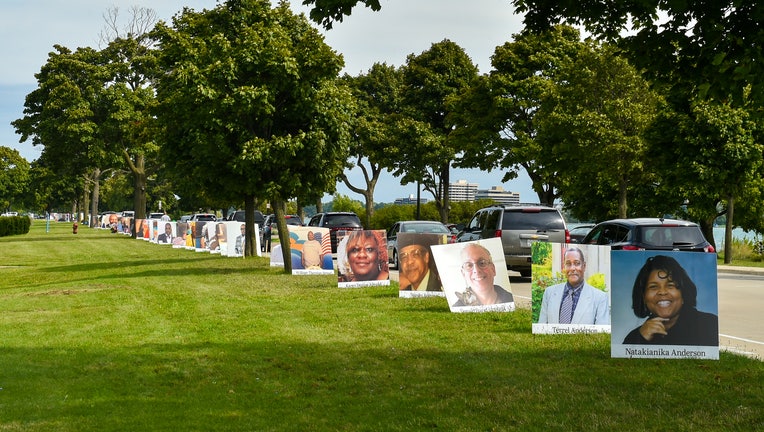Michigan's COVID-19 racial disparities gap is closing, according to recent data

DETROIT, MICHIGAN - SEPTEMBER 02: Images of COVID-19 victims from Detroit are displayed in a drive-by memorial at Belle Isle State Park on September 2, 2020 in Detroit, Michigan. Mayor Mike Duggan has declared "Detroit Memorial Day" on monday, August
DETROIT (FOX 2) - Michigan Gov. Gretchen Whitmer released data Monday that shows significant progress has been made toward reducing the disparate impact COVID-19 has had on communities of color.
The data shows that the disparity in COVID-19 cases and deaths between African American and white Michiganders are lower now, in the later part of the pandemic, than they were in the beginning.
“The aggressive action we have taken in Michigan has no doubt saved thousands of lives, especially among our most vulnerable communities - people of color, seniors, and people with disabilities,” said Gov. Whitmer in a press release. “The work of the Coronavirus Task Force on Racial Disparities, spearheaded by Lieutenant Governor Gilchrist, has helped us dramatically reduce the number of African Americans who have been impacted by COVID-19. We are not out of the woods yet, and must continue to do our part to save lives and protect our brave frontline workers. The Rapid Response Grant Program will help us continue this hard work and create a blueprint that states across the country can follow to protect their most vulnerable.”
COVID-19 CASES
While Black residents only make up 15% of Michigan’s population, they represented a staggering 29.4% of the cases and 40.7% of the deaths in the early days of tracking COVID-19 data based on race. In the past two weeks of available data, Black residents account for 8.2% of cases and 9.9% of deaths.
White residents make up 80.4% of Michigan's population. During the entire outbreak, 67.3% of COVID-19 cases were among white Michiganders and in the past two weeks, data shows 88.7% of cases were.
COVID-19 DEATHS
Black residents make up 15% of Michigan's population and, across the entire outbreak, made up 40.7% of COVID-19 deaths. In comparison, in the past two weeks, African American Michiganders made up just 9.9% of deaths.
White residents make up 80.4% of Michigan's population and, during the entire outbreak, made up 57.6% of COVID-19 deaths. In the past two weeks, 88.0% of deaths were among white residents.
“We have reason to be proud of the hard work and progress made to reduce the disparate impact of COVID-19 on Black people,” Lt. Governor Gilchrist said. “However, we cannot lose sight of the fact that we are still in the midst of a pandemic that continues to take the lives of our friends and family. We still have work to do to tackle generations of racial disparities and inequality to ensure that all Michiganders can lead happy and healthy lives. And more than anything else we need to keep the Governor’s emergency measures in place to limit the spread of this virus, which we know causes disproportionate harm among people of color who start out in a more vulnerable position.”
TASK FORCE ACTION
The administration took action to tackle racial disparities early on in the pandemic through executive orders issued under Gov. Whitmer's emergency powers. The administration also launched the Michigan Coronavirus Task Force on Racial Disparities to act in an advisory capacity to the governor. The task force studied the causes of racial disparities in the impact of COVID-19 and recommended actions to immediately address such disparities and the historical and systemic inequities that underlie them.
The administration also launched the Michigan Coronavirus Task Force on Racial Disparities to act in an advisory capacity to the governor. The task force studied the causes of racial disparities in the impact of COVID-19 and recommended actions to immediately address such disparities and the historical and systemic inequities that underlie them.
The task force’s broad-based representation and collaboration with State Departments facilitated swift actions, such as:
- Distributing large quantities of masks to the public
- Launching a strategic communications and social media effort targeting communities of color
- Collaborating with regional racial disparity task forces to share data and recommendations for additional actions
- Increasing access to coronavirus testing in communities of color through drive-thru, walk-up, and mobile testing sites
RELATED: Wayne State president says COVID racial disparities have been eliminated in Michigan
“Swift actions have been taken to address the health inequities that existed prior to the pandemic and were exacerbated by the virus. Access to testing and adequate resources to protect communities of color will continue to be a priority as we fight COVID-19.” said Dr. Joneigh Khaldun, Chief Medical Executive and Chief Deputy for Health at MDHHS. “I applaud the racial disparities task force and the multiple partners on the ground who helped decrease this disparity. However, we cannot let our guard down. We must continue to take precautions including wearing masks, maintaining social distancing of at least six feet from others, washing our hands often and staying home if we are feeling ill.”
To continue the administration’s efforts to tackle racial disparities, the State of Michigan has created the Rapid Response Grant program, which has awarded 31 grants for a total of nearly $20 million of CARES funding to local organizations.
The grants must be used to address food and housing insecurity, provide technology and tablets, increase access to testing and flu vaccines, improve contract tracing, provide basic needs, and fund operations.
You can further view the MDHHS data on racial disparities online here.

